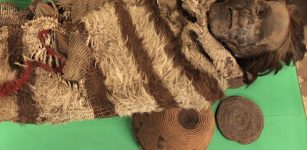Why Is La Ferrassie Man A Unique And Famous Neanderthal?
Jan Bartek - AncientPages.com - Scientists have unearthed the remains of hundreds of Neanderthals, but until this day, no one is as unique and famous as the La Ferrassie Man (LF1).
The skull of La Ferrassie 1 on display at Wollaton Hall in Nottingham, UK. Credit: Mike Peel - CC BY-SA 4.0
The Neanderthal was discovered at the La Ferrassie rock shelter in the Dordogne Valley, France in 1909. At the site were also the remains of an adult woman and several Neanderthal children. How and why all these individuals ended up in the cave has long intrigued scientists, but it seems it is a case of intentional burial. The rock shelter was repeatedly occupied by Neanderthals during millennia.
The famous Neanderthal’s skeleton has been dated to between 40,000 and 54,000 years. Studies of LF1’s remains revealed La Ferrassie Man was about 50 years at the time of his death. Scientists have not been able to determine the lifespan of Neanderthals, but finding an individual who lived more than 45 years is rare, which is why La Ferrassie Man is considered an old man. He was also around 171 centimeters (5 feet and 7 inches) tall, and his leg and foot bones clearly showed he could walk upright, just like humans.
The Neanderthal suffered various broken bones during his lifetime and had ongoing respiratory issues when he died. Neanderthal cultural practices are often discussed. Was burial of the dead practiced by Neandertals, or is it an innovation specific to our species? Were Neanderthals really capable of such cultural sophistication? Though some scientists remain skeptical, there is evidence the Neanderthals did bury their dead.
Researchers say La Ferrassie Man was deliberately buried in the pit by other members of his social group.
The skeleton of La Ferrassie Man is “one of the most important Neanderthal individuals both for its completeness and due to the important role it has played historically in the interpretation of Neanderthal anatomy and lifeways.” 1
His skull, the largest and most complete Neanderthal skull ever found, has “many of the typical Neanderthal traits such as the low, sloping forehead and large nasal opening.” 2
His front incisors show a slanted wear that does not occur from chewing; one hypothesis to explain this odd wear on his teeth is that he habitually held something in place between his front teeth, such as a hide, that he then scraped with a tool. Although this hypothesis has been debated, the use of the teeth as tools may represent a remarkable Neanderthal behavioral adaptation.” 3
La Ferrassie Man is an extraordinary scientific discovery that still provides new insights into Neandertal anatomy and behavior.
Written by Jan Bartek - AncientPages.com Staff Writer
Copyright © AncientPages.com All rights reserved. This material may not be published, broadcast, rewritten or redistributed in whole or part without the express written permission of AncientPages.com
- Binghamton University - New technology reveals secrets of famous Neandertal skeleton, La Ferrassie 1
- Smithsonian Institution Human Origins - La Ferrassie
- Asier Gómez-Olivencia, Rolf Quam, Nohemi Sala, Morgane Bardey, James C. Ohman, Antoine Balzeau. La Ferrassie 1: New perspectives on a “classic” Neandertal. Journal of Human Evolution, 2018; 117: 13 DOI: 10.1016/j.jhevol.2017.12.004
- Jean-Pierre Bocquet-Appel and Anna Degioanni - Neanderthal Demographic Estimates
More From Ancient Pages
-
 Bassetki Cuneiform Tablets Reveal Location Of Lost City Of Mardaman In Northern Mesopotamia
Archaeology | May 14, 2018
Bassetki Cuneiform Tablets Reveal Location Of Lost City Of Mardaman In Northern Mesopotamia
Archaeology | May 14, 2018 -
 Why Are Statues Of Mythical Yeti Dividing People In The Himalayas?
Featured Stories | Feb 18, 2020
Why Are Statues Of Mythical Yeti Dividing People In The Himalayas?
Featured Stories | Feb 18, 2020 -
 407-Million-Year-Old Plant Fossil Challenges Long-Held Theory On Fibonacci Spirals Found In Nature
Evolution | Jun 22, 2023
407-Million-Year-Old Plant Fossil Challenges Long-Held Theory On Fibonacci Spirals Found In Nature
Evolution | Jun 22, 2023 -
 Judahite Shrine Of Biblical Arad Reveals Ancient Use Of Cannabis And Frankincense
Archaeology | Jun 2, 2020
Judahite Shrine Of Biblical Arad Reveals Ancient Use Of Cannabis And Frankincense
Archaeology | Jun 2, 2020 -
 Migration Of Early Humans Out Of Africa Began Thousands Of Years Earlier Than Previously Thought
Archaeology | Dec 18, 2017
Migration Of Early Humans Out Of Africa Began Thousands Of Years Earlier Than Previously Thought
Archaeology | Dec 18, 2017 -
 Ancient Mystery Of Egypt’s Black Pyramid – Did It Really Exist?
Featured Stories | Nov 28, 2020
Ancient Mystery Of Egypt’s Black Pyramid – Did It Really Exist?
Featured Stories | Nov 28, 2020 -
 On This Day In History: King Tut’s Tomb Is Unsealed And Opened – On Feb 16,1923
News | Feb 16, 2017
On This Day In History: King Tut’s Tomb Is Unsealed And Opened – On Feb 16,1923
News | Feb 16, 2017 -
 Unexpected Danger Lurks Beneath Ancient Maya Cities – Mercury Pollution Discovered
Archaeology | Sep 23, 2022
Unexpected Danger Lurks Beneath Ancient Maya Cities – Mercury Pollution Discovered
Archaeology | Sep 23, 2022 -
 Unsolved Mystery Of The Aleppo Codex And Its Missing Pages: One Of The World’s Most Precious Ancient Books
Ancient Mysteries | Feb 27, 2017
Unsolved Mystery Of The Aleppo Codex And Its Missing Pages: One Of The World’s Most Precious Ancient Books
Ancient Mysteries | Feb 27, 2017 -
 Long Mysterious Tunnel Discovered Inside The Khufu Pyramid
Archaeology | Mar 2, 2023
Long Mysterious Tunnel Discovered Inside The Khufu Pyramid
Archaeology | Mar 2, 2023 -
 Bristol Academic Cracks Voynich Code – Century-Old Mystery Solved
Archaeology | May 15, 2019
Bristol Academic Cracks Voynich Code – Century-Old Mystery Solved
Archaeology | May 15, 2019 -
 Diver Says He Found Mysterious Underwater Ancient Tomb, Ruins And Artifacts Of An Unknown Advanced Civilization
Featured Stories | Oct 10, 2023
Diver Says He Found Mysterious Underwater Ancient Tomb, Ruins And Artifacts Of An Unknown Advanced Civilization
Featured Stories | Oct 10, 2023 -
 Ancient Monuments The World Is Not Allowed To See – Reason For Denial? – Part 1
Ancient Mysteries | Aug 24, 2020
Ancient Monuments The World Is Not Allowed To See – Reason For Denial? – Part 1
Ancient Mysteries | Aug 24, 2020 -
 Enigma Of Ancient Bell-Shaped Metal Vase Found In Solid Sedimentary Rock
Artifacts | Jun 6, 2019
Enigma Of Ancient Bell-Shaped Metal Vase Found In Solid Sedimentary Rock
Artifacts | Jun 6, 2019 -
 Elizabeth Woodville: Mother Of The Princes In The Tower And Commoner Queen
Featured Stories | Jul 16, 2018
Elizabeth Woodville: Mother Of The Princes In The Tower And Commoner Queen
Featured Stories | Jul 16, 2018 -
 DNA Taken From Cement On Hairs Belonging To Ancient Mummies Shed Light On South American Ancestry
Archaeology | Dec 29, 2021
DNA Taken From Cement On Hairs Belonging To Ancient Mummies Shed Light On South American Ancestry
Archaeology | Dec 29, 2021 -
 Bone Fragments Found Inside Mysterious Medieval Pendant
Archaeology | Jan 5, 2023
Bone Fragments Found Inside Mysterious Medieval Pendant
Archaeology | Jan 5, 2023 -
 142,000-Year-Old Shell Beads Found In A Cave Are The Oldest Known Evidence Of Human Communication
Archaeology | Oct 16, 2021
142,000-Year-Old Shell Beads Found In A Cave Are The Oldest Known Evidence Of Human Communication
Archaeology | Oct 16, 2021 -
 Mystery Of Monte d’Accoddi: Was It An Ancient Step Pyramid, Altar Or Astronomical Observatory?
Civilizations | May 17, 2016
Mystery Of Monte d’Accoddi: Was It An Ancient Step Pyramid, Altar Or Astronomical Observatory?
Civilizations | May 17, 2016 -
 King David-Era Fort Unearthed In Golan Heights Sheds Light On Aramean Kingdom Of Geshur
Archaeology | Nov 14, 2020
King David-Era Fort Unearthed In Golan Heights Sheds Light On Aramean Kingdom Of Geshur
Archaeology | Nov 14, 2020

